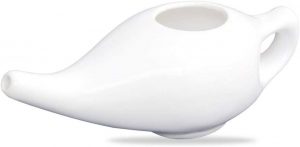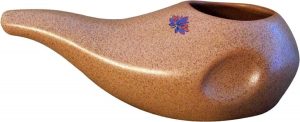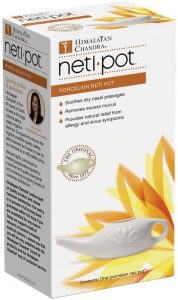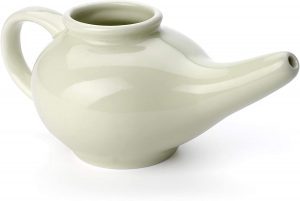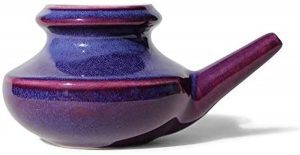The Best Ceramic Neti Pot
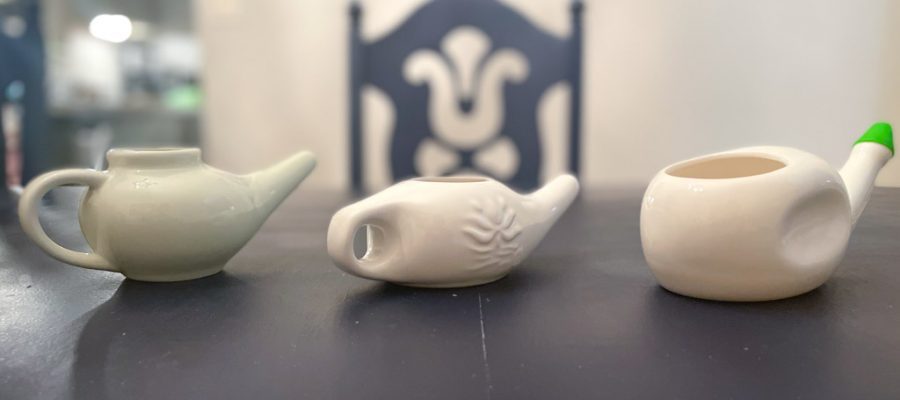
Our Review Process
Don't Waste Your Money is focused on helping you make the best purchasing decision. Our team of experts spends hundreds of hours analyzing, testing, and researching products so you don't have to. Learn more.
Our Picks For The Top Ceramic Neti Pots
Keep your nasal passages free of allergens using this ceramic neti pot. It has a 200-milliliter water tank and is designed without joints, so you won't have to worry about leaks. The pot is even dishwasher safe for easy cleaning.
Economical PickYou'll love the budget-friendly price tag on this affordable ceramic neti pot.
The ergonomic design of this ceramic neti pot means it's easier to hold than other models on the market. Use it to moisten your nasal passages, relieve sinus pressure or wash away dust and other annoying allergens. Afterward, place the pot in your dishwasher for a good cleaning.
Multiple Color OptionsYou'll find this ceramic neti pot comes in a choice of dusk red, clay brown, dove white and seafoam green.
Size is a factor when finding the right neti pot, and the handle for this one makes it easy to grip for most. The ceramic material is free of lead or other harmful substances that can leach into the water. It's also dishwasher safe, which is a plus.
Safe to HandleIt's easy to hold and clean this compact ceramic neti pot.
This neti pot resembles a petite teapot, which makes it look great on any countertop. In terms of function, the spout is designed to make a good seal around the nostril and prevent spillage. When the procedure is finished, it's a simple matter to clean it in a standard dishwasher.
Ergonomically Shaped SpoutThis ceramic neti pot fits neatly around most nostrils.
The main highlight on this pot is its handcrafted look and feel. It is made from lead-free ceramic materials that can be cleaned in any dishwasher. The extra-wide spout connects nicely and allows for more water flow through the nasal passage.
High Grade CraftsmanshipWith a wider spout, this ceramic neti pot can deliver relief quickly.
Buying Guide
For a long time now, yoga techniques have been a standard part of many fitness routines in the west. But there’s one practice that took a little longer to catch on, and that involves the use of the neti pot.
Even if you haven’t used a neti pot before, there’s a good chance you’ve seen one. Maybe you’ve even mistaken it for a teapot. These small, tapered pots get their name from the yogic practice of “yala-neti,” or nasal irrigation. They’re specifically designed to allow you to pour a special mixture of salt water into your nostril. Do this while breathing through your mouth and with your head tilted, and the mixture flows out through your other nostril — taking any excess mucus or allergens with it.
This may seem strange and uncomfortable at first, but it isn’t just a fad ritual. Even the CDC and FDA have guidelines on the use of neti pots, acknowledging that their proper use can help relieve congestion and restore normal breathing. This can lead to less snoring and a number of other fringe benefits. It’s been used successfully for hundreds of years, but as with any such practice you should consult with a medical practitioner before trying it out.
With that in mind, how do you choose the right neti for you? Most of the neti pots you’ll find will be made of ceramic, and there are many good reasons for that. Ceramic containers are easy to clean, first of all. That’s vitally important when we’re talking about an object that’s going anywhere near a nasal cavity. You can find glass, plastic or even steel neti pots, but whatever material they’re made out of, make sure that you can wash them thoroughly in a standard dishwasher. A simple design is usually best, since you don’t want any tiny crevices where mold can build up.
Plastic neti pots can have their advantages, especially if you plan on traveling. Obviously they’re a lot harder to break and for some they’re even easier to use. The ability to squeeze the container and regulate the water pressure can be helpful, though for the most part you can let gravity do all the work once you get the hang of things. Just make sure that the plastic is free of BPAs or other chemicals that can leach into the water.
The spout is probably the most important part of your neti pot. The design should allow you fine control over the flow, since too much water too fast just makes for an awkward mess and no relief. Remember that the tip shouldn’t be too thin unless you’ve got a small nose. You don’t want to stick the spout down too far inside your nostril; you just want to form a tight seal over it so the water goes through cleanly.
Finally, just because you’re using it for a little self-care doesn’t mean it can’t look nice. Here’s where ceramic also has the edge. Again, most neti pots already look like miniature teapots, so get one that you’re proud to display on your countertop.
What to Look For
Even the best neti pot won’t do much for your breathing if you don’t use it correctly. Getting that fluid through your sinuses will get easier with practice, but the right mixture is crucial.
You should only ever use salt water in your neti pot, and not just any old salt water. Both elements of this mixture should be as pure as possible, starting with the water. You should use distilled or sterile water, but if you’re going with tap water you need to boil it first and then let it cool. A lukewarm temperature is best when it comes time to actually use your pot.
When mixing in the salt, follow carefully the instructions and proportions that come with your neti pot. Most pots will come with their own special salt, which will usually be a non-iodized form that’s as close to pure sodium chloride as possible. What you don’t want to use under any circumstances is regular table salt, which can contain preservatives that will irritate the nasal cavity.
Once you’re ready, tilt your head sideways over a sink. Breathe through your mouth and continue to do so as you pour the mixture from the neti pot into one nostril, allowing it to flow out the other. Blow to clear your nose, then repeat the process with the other nostril. The more you do it, the easier it gets, and you should start breathing easier immediately.
You May Also Enjoy Our Other Reviews
- Robotic Vacuum
- Cordless Vacuums
- Air Mattress
- Drone
- Electric Razor
- Convertible Car Seat
- Infant Car Seat
- Dry Dog Food
- Carpet Cleaners
- Air Fryers
- Laptops
- Home Printers
- Wireless Router
- Streaming Device
- Electric Pressure Cooker
- Chromebook
- Television
- Digital Camera To Capture Special Moments On The Fly
- Smartwatch
- Upright Vacuum


